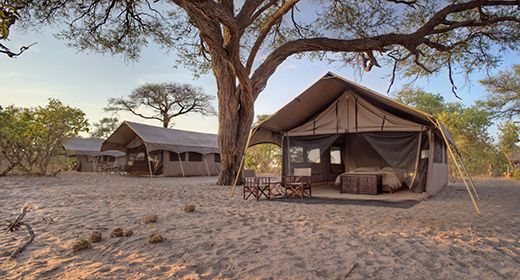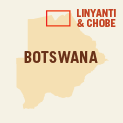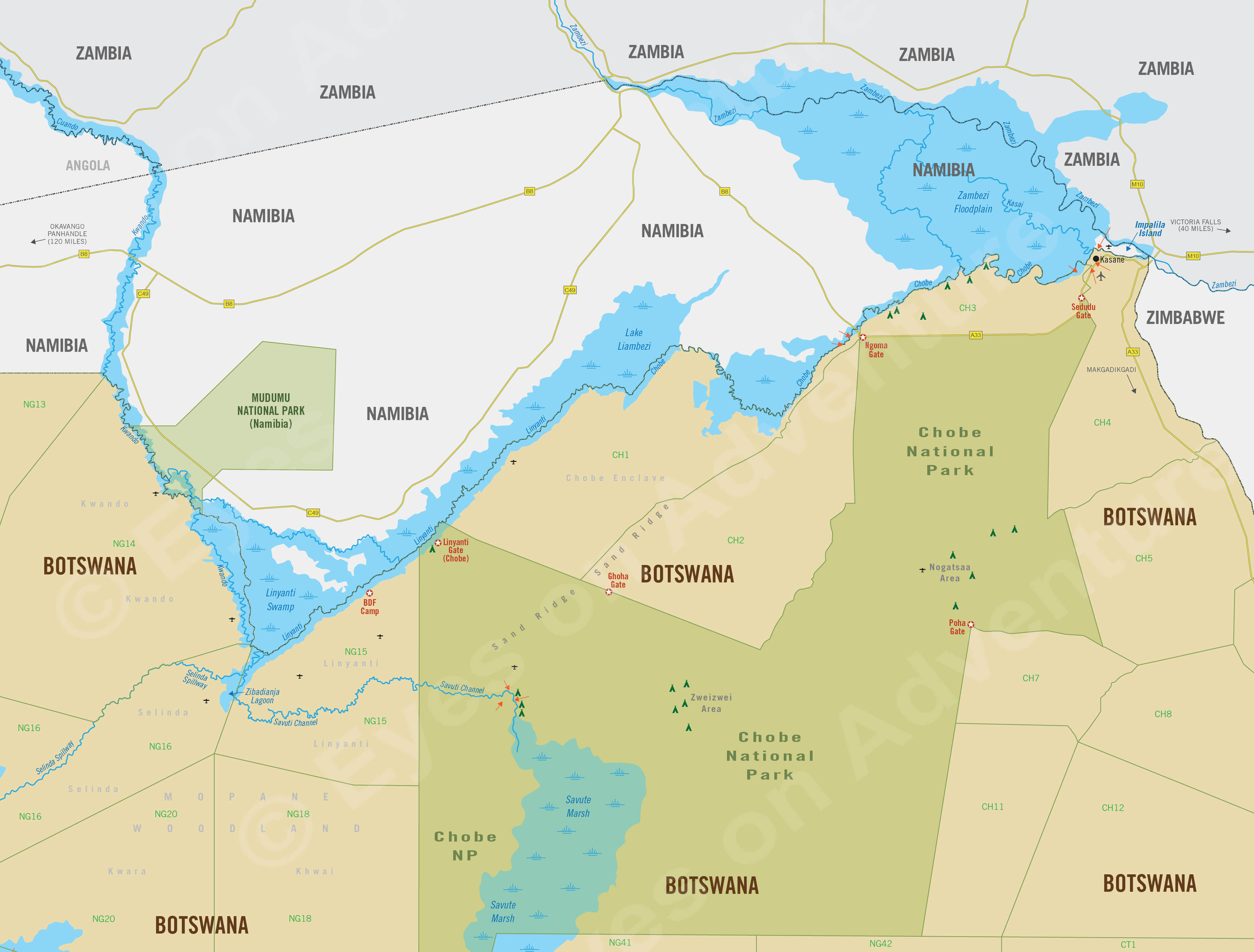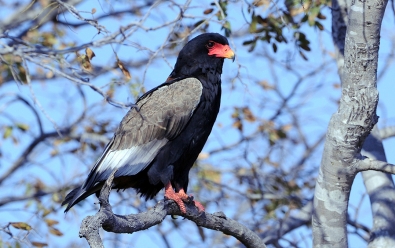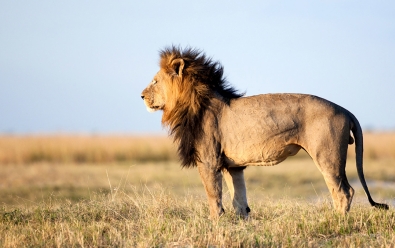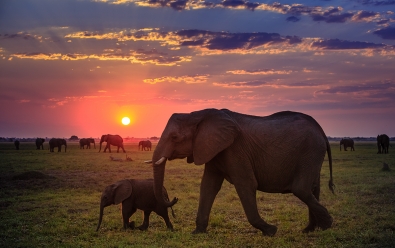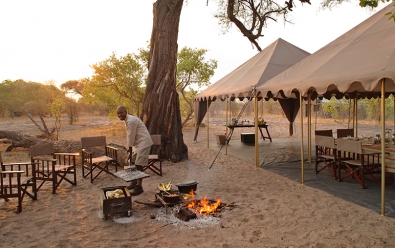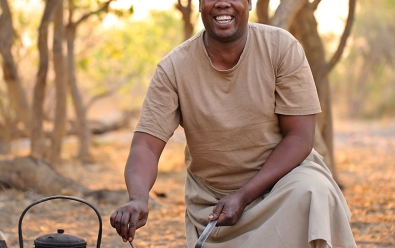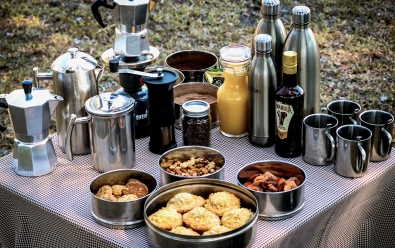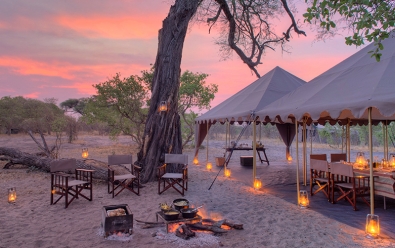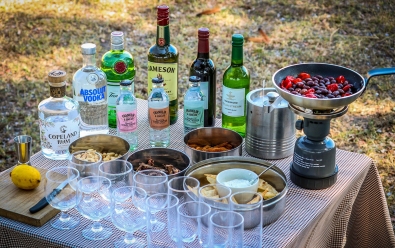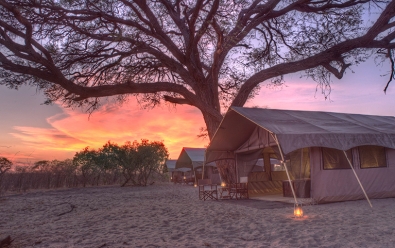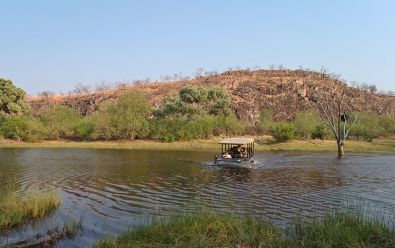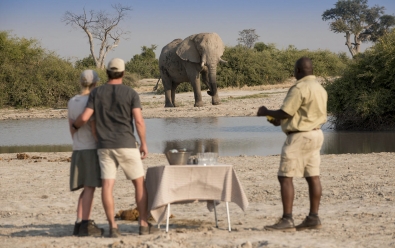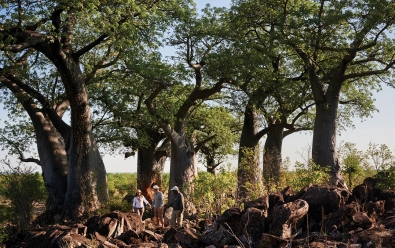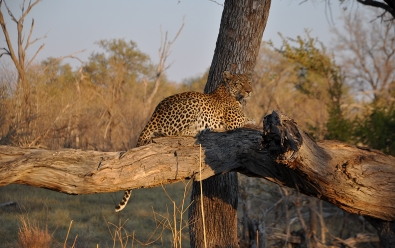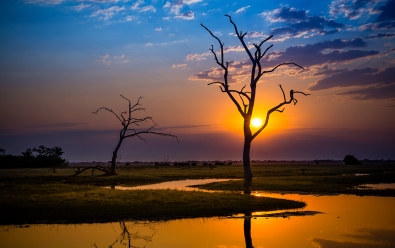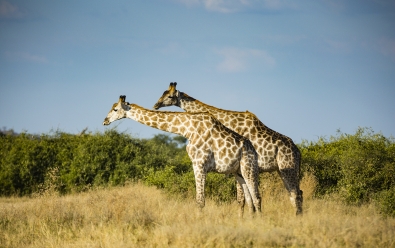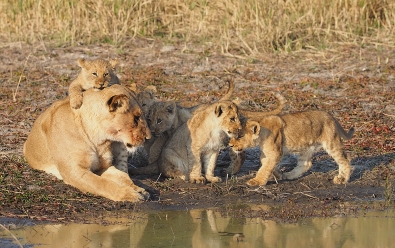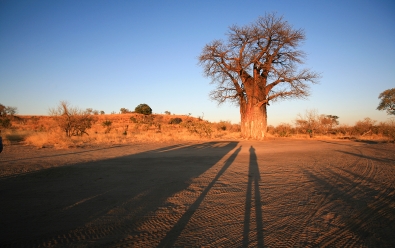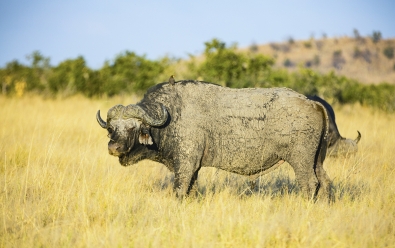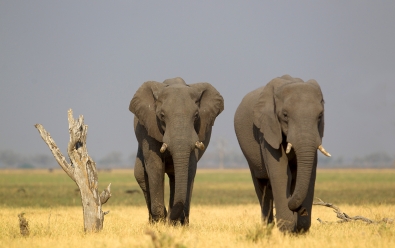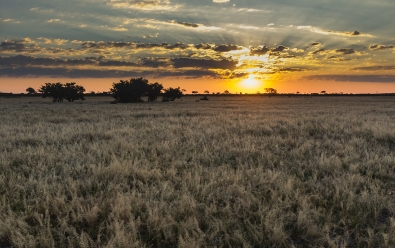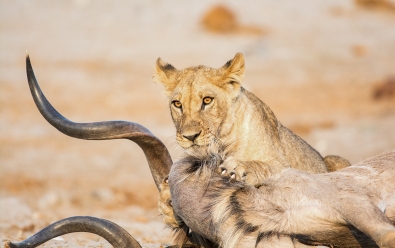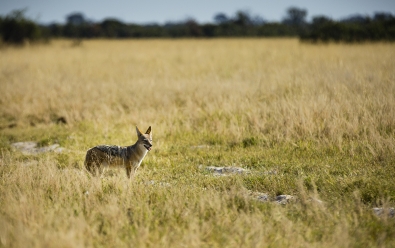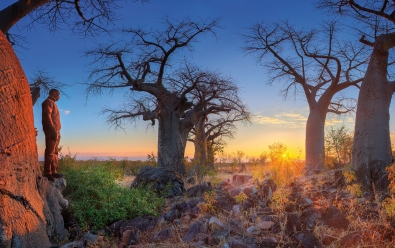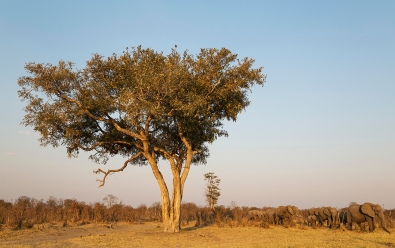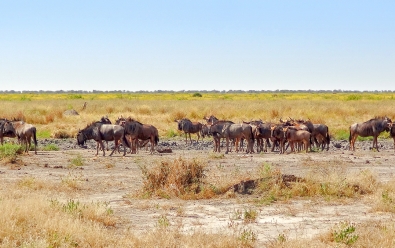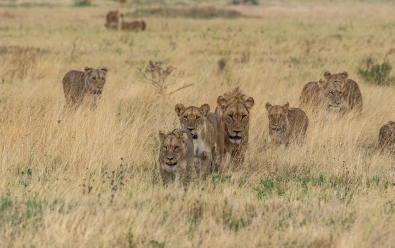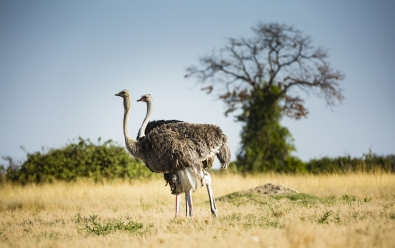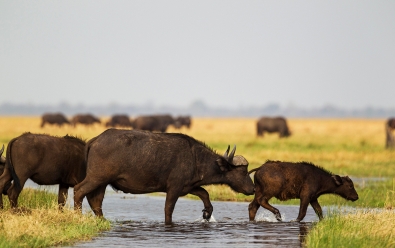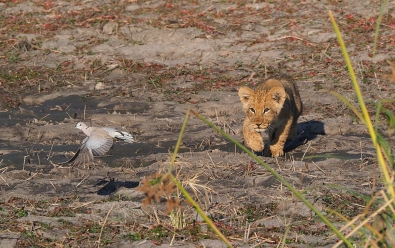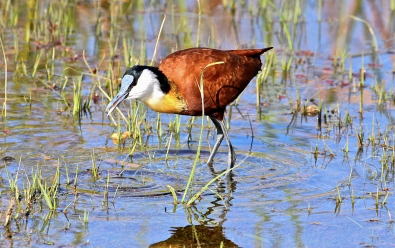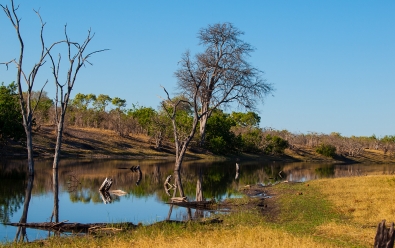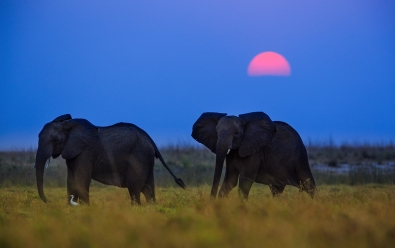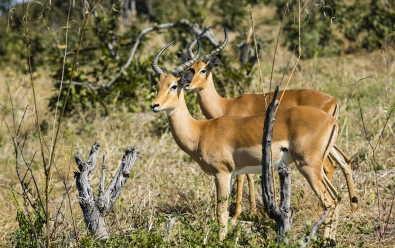Savute Under Canvas
Highlights
- Rustic and authentic safari experience with all necessary comforts.
- Savute Marsh is a unique ecosystem in otherwise dry Chobe interior.
- Great place to see mature bull elephants and prides of lion.
- The summer migration of thousands of zebra and wildebeest.
Location
- Savute Marsh
- Chobe National Park
- Northern Botswana
Savute Under Canvas offers a rustic but comfortable safari adventure like the days of old, before the advent of the extravagant luxury camps, and in a prime wildlife area of Chobe National Park.
Although the camp is technically a mobile camp, it is considered semi-permanent, as it remains in its location at the Savute Marsh in southwest Chobe. The Marsh receives its water (depending on whether the Savuti Channel is flowing or not) and is renowned for its elephants, predators, and the 'mini-migration' of zebras and wildebeests.
The camp's 5 Meru-style safari tents are spacious and comfortable, with 2 twins or a double bed, a separate toilet, and a bucket shower (hot water provided). The camp's main area is comprised of an open-sided canvas tent for dining and lounging and all meals are prepared over an open fire by the attentive staff.
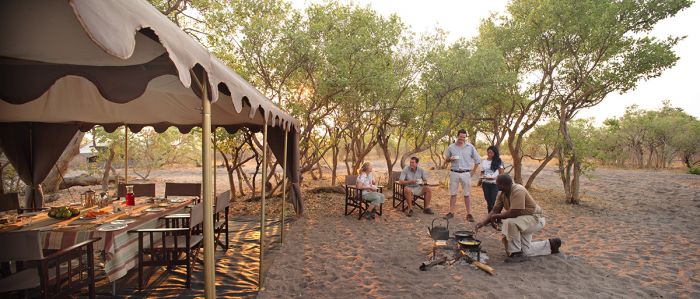
The main camp area at Savute Under Canvas.
There is no electricity and no W-Fi, which allows guests to disconnect from their everyday lives and enjoy a safari like those of yesteryear. Battery-powered and solar lighting is available to light the camp at night.
Activities include morning and afternoon safari drives in semi-open 4x4 vehicles to search for wildlife. The mini-migration of zebras and blue wildebeests arrives once the rains begin, normally sometime in November and they remain around The Marsh until the rains end sometime in April.
Wildlife is present year-round, sustained even during the dry season by the Marsh and a series of pumped waterholes around the safari camps located here. Other wildlife seen all year includes lion, buffalo, leopard, spotted hyena, giraffe, tsessebe, and greater kudu. Birding in The Marsh area is quite good, especially during the rainy season.
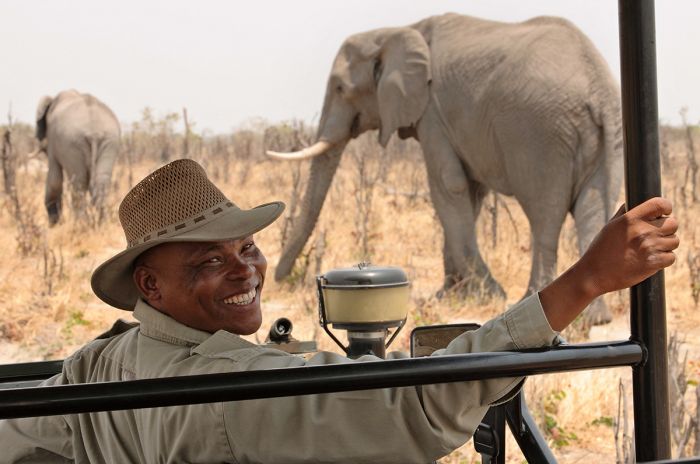
Game drive from Savute Under Canvas.
About Chobe National Park
Chobe was the first national park (proclaimed in 1968) in Botswana and covers a massive 4 250 square miles (11 700 sq kms) of mostly dry habitat other than along its northern border (close to the Chobe River) and in the Savute Marsh (southwest Chobe).
The Chobe Riverfront and Savute Marsh offer the best wildlife viewing in the park and the permanent safari camps and lodges, as well as numerous public camping sites, are located almost exclusively in these two areas.
The majority of the national park is dominated by mixed woodland and Acacia scrub, with some areas of mature mopane tree forest. The northern border of the park, which is just south of the Chobe River is mostly floodplain grassland, while the Savute Marsh is fed by water from the Savuti Channel, which originates in the Linyanti Swamp.
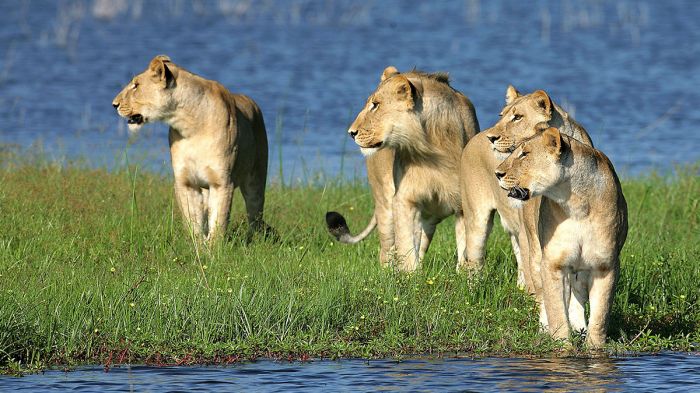
Lions at the Savute Marsh during the summer when the rains have transformed the area.
Chobe is situated atop the eastern extent of the Kalahari sands and there are some areas of vegetated sand ridges and dunes. The park also has many numerous pans that fill with water only during the rainy season between December and March. There are also some sand that have borehole pumps to help sustain the wildlife during the longer dry season.
During the dry season (July through October), Chobe's vast interior has little to no water, so the wildlife congregates along the Linyanti-Chobe river system, which forms the northern edge of the park. Safaris on the river during this are are spectacular, with hundreds of elephants visiting the rivers constantly.
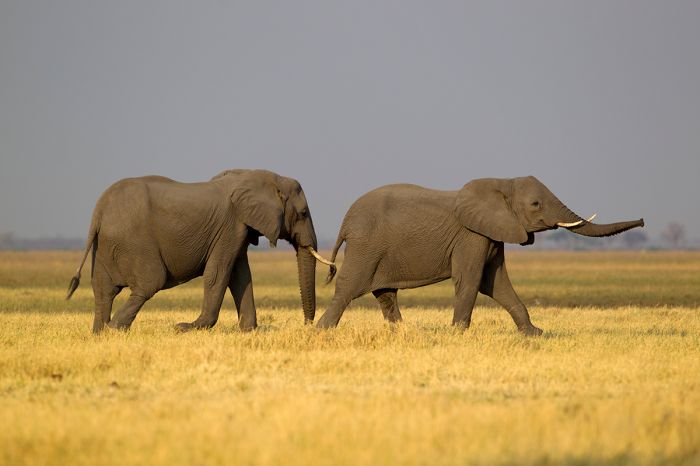
Elephants near the Savute Marsh.
Buffalo, red lechwe, greater kudu, impala, tsessebe, giraffe, zebra, and warthog are common in Chobe and hippo and crocodile are found in large numbers in the rivers. Eland, roan, and sable are present in smaller numbers. The most common predators in Chobe are lion and spotted hyena. African wild dogs are seen regularly and leopard, cheetah, black-backed jackal, and side-striped jackal are found along the northern floodplains and in the Savute Marsh.
Like too many other places in Africa, rhinos once roamed throughout Chobe, but were sadly exterminated by hunters by the 1990s. Birding in Chobe is very good, especially along the rivers, which have an abundance of waterbirds, raptors, and passerines. The Savute March also offers excellent birding, dependent upon water levels. Over 450 species of bird have been recorded in Chobe.
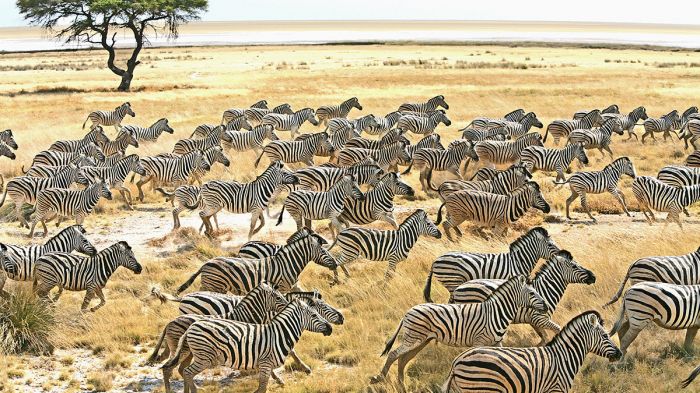
The 'mini-migration' arrives sometime around November.
About the Savute Marsh
Except for the floodplains and some riparian forest along the Linyanti-Chobe river system on the northern edge of the park, most of Chobe is covered in sand with a mix of dry bush, including mopane and Acacia scrub and some vegetated dune ridges. The exception is the Savute Marsh, located in the southwest of the park just east of the Linyanti region and which has rich grasslands and areas of well-wooded forest.
The Savute Marsh (note that the spelling is sometimes 'Savuti' and sometimes 'Savute') receives water that overflows from the Linyanti Swamp and travels east along the Savuti Channel. This 'on-again-off-again' channel covers 35 miles (56 kms) as the crow flies before it spills out south into a depression and creates a wetland.
The Savuti Channel has gone through many wet and dry cycles over the centuries, with multi-year periods of total dryness, followed by years of strong flows. The skeletons of dead trees can be found both in the channel and in the Savute Marsh, many of them leadwood (Combretum imberbe) trees, which have very dense wood that is resistant to insects and which can stand for decades ofter dying. The skeletal leadwoods in the Savute Marsh are dated to a dry cycle from the 1880s to the 1950s, after which flooding again occurred, killing the trees.
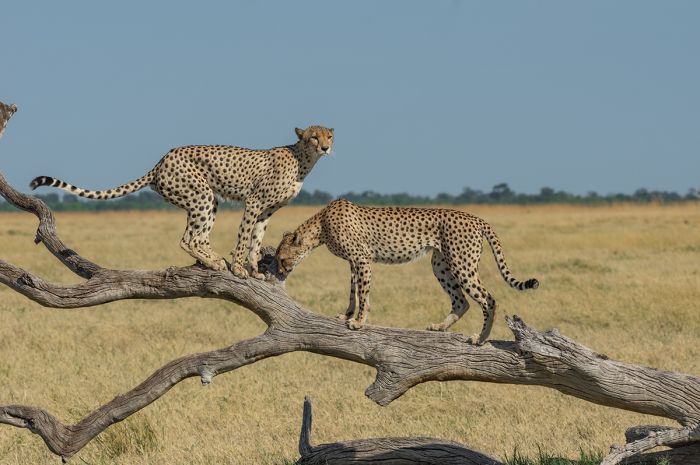
Cheetahs in the Savute Marsh area of Chobe National Park.
The Savute Marsh attracts good numbers of wildlife and even in dry cycles, a number of pumped waterholes keep the animals around, providing the only source of water for many miles during the dry season months from June through October.
The Savute Marsh is well known for having large prides of lion and good numbers of elephant. Some of the old bull elephants are resident at The Marsh, while breeding herds regularly pass through on their way to and from the Okavango Delta and the Chobe Riverfront. Leopards are also common here, living in the small pockets of forest and along the rocky outcrops present around the area. Spotted hyena are also found around The Marsh in good numbers. Cheetah and African wild dog are also seen on occasion.
During and just following the rain months (November to mid-April), blue wildebeest and plains zebra move to the Savute Marsh to graze on the freshly grown, nutritious grasses and are found in good numbers, especially in January and February. Herds of buffalo are found along the Savuti Channel if it has ample water and they can also be found around The Marsh. The Acacia woodlands at at the southern side of The Marsh are a good place to find giraffe and sometimes oryx.
Birdlife around The Marsh is very good, especially if it has plenty of water and also during the breeding season (which coincides with the rains), when migratory species are present.
ROOMS INCLUDES & EXCLUDES CHILDREN FACILITIES ACTIVITIES
Accommodation
Savute Under Canvas is a semi-permanent camp with 5 guest accommodations in total comprising:
- 5 comfortable canvas safari tents, each with two twin beds that are covetable to a double bed upon request (to be advised in advance).
Each guest tent is set up on the ground and has an en-suite bathroom with a separate flush toilet and indoor bucket shower (hot water provided upon request).
The tents are connected to the camp's main tented dining and lounge area by sandy footpaths on the ground.
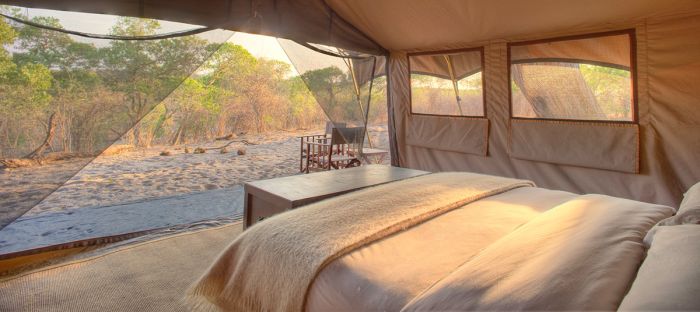
Guest tent interior and view at Savute Under Canvas.
The Meru-style safari tents are perfect for those seeking a rustic safari like the days of old, but with all necessary comforts provided. There is a small seating area with table and chairs on the ground in front of the zip-up tent entrance.
Other items and features include:
- Battery-powered lighting in the tents.
- No Wi-Fi, so enjoy being disconnected from the everyday world.
- The campsites are not fenced off and guests need to be extremely vigilant at all times.
Savute Under Canvas can accommodate a maximum of 10 guests in total: 2 persons in each of the 5 guest tents.
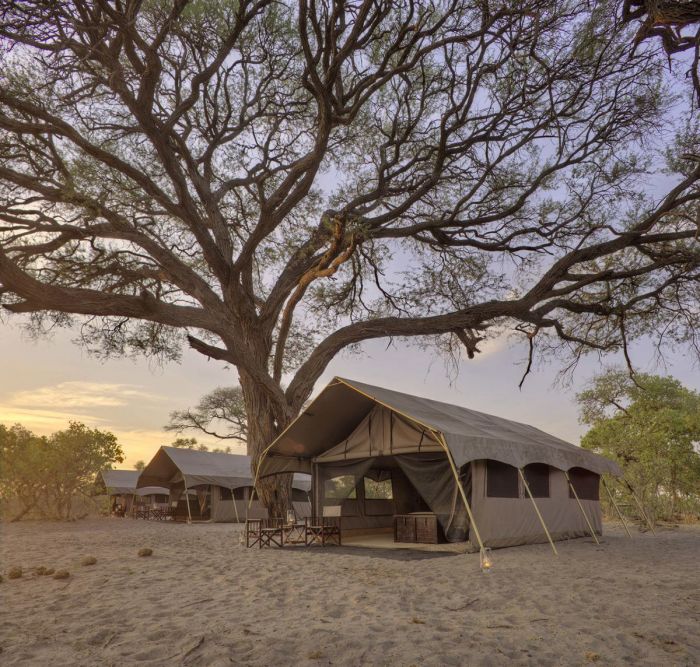
Guest tent setting.
Includes & Excludes
Includes:
- All meals and local beverages including soft drinks, house wines, local brand spirits and beers, teas, and coffees.
- Safari experiences (twice-daily game drives in semi-open 4x4 vehicles and birding) accompanied by an experienced guide.
- No laundry services; however guests will be provided with washing suds to do their laundry.
- A complimentary pair of Swarovski Optik CL Companion 8×30 binoculars per tent for use during your stay.
- Emergency medical evacuation insurance.
- Tourism Levy & VAT.
Excludes:
- Laundry.
- Any applicable wildlife fee, park fee, reserve fee, concession fee, other land-use fee.
Single Supplement
A single supplement may apply for any room booked by a single traveler; please ask us for pricing.
Children
Children aged 12 years and above are accommodated at Savute Under Canvas:
- Triple tents are not available.
Facilities
Main guest area facilities include:
- The common guest area comprises open-sided tents for dining, pre-dinner drinks, or simply whiling away the time between game viewing adventures with a good book and a beverage.
- Delicious and hearty meals are cooked by the staff over the open fire.
- No electricity, but solar-powered lights.
Activities
Activities included in the rate:
- Morning and afternoon game drives in semi-open 4x4 vehicles.
- The vehicles have 12-volt power for charging and a fridge for drinks and snacks while on drive.
- Private activities are not offered.
- A complimentary pair of Swarovski Optik CL Companion 8×30 binoculars per tent for use during your stay.
- Birding.
- Stargazing.
Savute Marsh
Great Good Fair Poor
- Jan
- Feb
- Mar
- Apr
- May
- Jun
- Jul
- Aug
- Sep
- Oct
- Nov
- Dec
Savute Under Canvas is located at the Savute Marsh.
Chobe Riverfront
Great Good Fair Poor
- Jan
- Feb
- Mar
- Apr
- May
- Jun
- Jul
- Aug
- Sep
- Oct
- Nov
- Dec
When to Go
Chobe National Park offers good wildlife viewing opportunities throughout the year, but there are definitely seasonal variations in terms of weather and the densities of wildlife that may be a consideration when planning your visit.
The high season in terms of tourist demand is during the dry months between July and October, particularly along the Chobe Riverfront, which becomes a true wildlife spectacle with hundreds of elephants visiting the banks throughout the day.
Once the rains abate sometime in April, Chobe's waterholes becomes very dry, so most of the animals move north to the river. Some animals also move towards the Savute Marsh in the western part of the park.
The latter part of the rainy season (February through April) is the low season in general, although the lush grasslands around the Savute Marsh are full of zebras and blue wildebeest, which have migrated there for the fresh grasses beginning around late November and staying until the rains end.
Savute Under Canvas operates year-round except for January, when it closes for maintenance.
SUMMER / RAINS
Northern Botswana, including Chobe National Park, receives most of its rain between December and February, which is the summer season. November and December are good months to visit the Savute Marsh area, with only occasional rainstorms and most rain coming in short showers, bringing welcome relief to the thirsty land after the dry season.
The rich grasslands around The Marsh turn green almost overnight after the first rains and the 'mini-migration' of zebras and blue wildebeests arrive between November and December in large numbers to graze on the new grasses. The is a lovely time to stay in The Marsh.
The Chobe Riverfront is not the place to visit once the rains arrive because the wildlife is able to disperse into the core of the park, where the rain pans are filling with water and plenty of new vegetation is available everywhere.
January and February typically experience afternoon downpours on most days, but all-day rains are uncommon. By the middle of March, the rains become much less frequent and the grass and bush have grown long and thick. Mornings become cooler by the end of March.
In spite of being summer, the rains keep temperatures from becoming overly hot, although humidity and insect life are at their peak. Days are mostly overcast or partially cloudy, with dramatic skies and a lovely green color to the landscape. Afternoon temperatures average 88°F (31°C), but mornings are very comfortable at around 65°F (19°C).
Baby animals are in abundance, especially impala lambs and warthog piglets. Migratory birds arrive to breed and dramatically increase the number of species and overall numbers, particularly in the lagoons and pans, which are full of rain water and food for the aquatic species.
Unlike the dry months (May through October), when the middays can be very warm, causing wildlife to minimize activity and seek shade from around 10am til mid-afternoon, the overcast skies during the summer often mean that animals are active throughout the day, offering many more hours of game viewing.
AUTUMN
March, April and May are Fall season months and the transition period toward the coming dry season in Chobe, with rains very uncommon from around mid-March. The landscape is still lush and green, with sunny days and comfortable temps; afternoons average 84°F (29°C). Mornings are comfortable, but a fleece and base layer may be needed for the first hours on game drive.
Migrant birds fly north and water in the lagoons and rain pans is drying up. Permanent waterways, including the Kwando, Linyanti, and Chobe rivers, are actually rising however, as the 'flood' water from the Angolan highlands is now reaching into northern Botswana. As a result of the rains abating and the waterholes away from the river becoming dry, animals begin to spend their time closer to these rivers, and wildlife sightings become better and better.
Morning temps are around 54°F/12°C and afternoons average 79°F/26°C.
WINTER / DRY SEASON
June through August is winter and the vegetation is drying and going dormant. The water in the Linyanti/Chobe river system is peaking, but the surrounding landscape is mostly brown and yellow. Dust and sand particles in the air is on the rise. Game viewing along the Chobe Riverfront is becoming better and by July, the river and floodplains are absolutely pumping with wildlife, with elephant and buffalo herds congregating in great numbers.
Mornings can be chilly to very cold at around 45°F (7°C). Warm clothes, including winter hat and gloves are needed for the open-air game drives. Dress in layers, as the temps do rise quickly during the day, with middays reaching 79°F (26°C).
Wildlife sightings along the Chobe Riverfront are non-stop boat-based safaris are the best way to see the wildlife. Elephants are around every bend and even swim back and forth across the river to Namibia and back. July through October on the Chobe River is simply outstanding for safaris.
SPRING
September and October are the driest months as the landscape and animals eagerly await the coming rains. Game viewing in both The Savute Marsh and Chobe Riverfront is phenomenal, with all rain pans now completely dry and animals congregating around the only places in Chobe where permanent water can be found.
Days are warm, sunny, and often cloudless and by mid-morning, most animals are seeking shelter in the shade and awaiting the evening temps to drop. October can be brutally hot and dusty and even smoky as sporadic grass fires can occur.
Safari camps are mostly full to capacity. Temperatures in October can easily reach 95°F (35°C) or even hotter.




